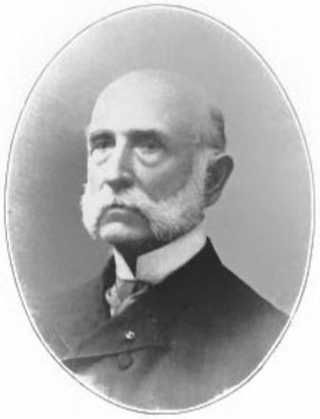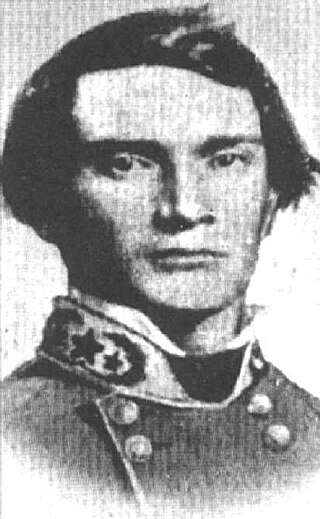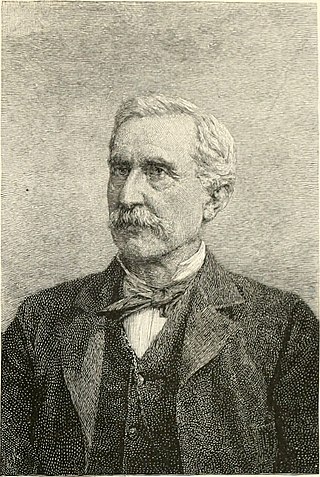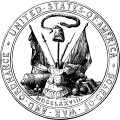
William Birney was an American professor, Union Army general during the American Civil War, attorney and author. An ardent abolitionist, he was noted for encouraging thousands of free black men to join the Union army.

Samuel Jones was a major general in the Confederate States Army during the American Civil War. At the midpoint of the war, he commanded the Department of Western Virginia, defending the Virginia and Tennessee Railroad and the vital salt mines. Later he commanded the district of South Carolina.

Thomas Taylor Munford was an American farmer, iron, steel and mining company executive and Confederate colonel and acting brigadier general during the American Civil War.

Thomas Howard Ruger was an American soldier and lawyer who served as a Union general in the American Civil War. After the war, he was a superintendent of the United States Military Academy at West Point, New York.
The Military Division of the Mississippi was an administrative division of the United States Army during the American Civil War that controlled all military operations in the Western Theater from 1863 until the end of the war.

Charles Lane Fitzhugh was a Union Army colonel during the American Civil War, who was later appointed a brevet brigadier general of volunteers for gallantry, energy and ability and a brevet brigadier general in the regular U.S. Army for gallant and meritorious services in the field during the war.

Eli Long was a general in the Union Army during the American Civil War.

William Henry Forney was an Alabama legislator, a brigadier general in the Confederate States Army during the American Civil War and U.S. Representative from Alabama from March 4, 1875 to March 3, 1893.

The Department of the Gulf was a command of the United States Army in the nineteenth and early twentieth centuries and of the Confederate States Army during the Civil War.

Martin Luther Smith was an American soldier and civil engineer, serving as a major general in the Confederate States Army. Smith was one of the few Northern-born generals to fight for the Confederacy, as he had served most of his early military career in the South with the United States Army's topographical engineers, marrying a native of Athens, Georgia. He planned and constructed the defenses of Vicksburg.

John Horace Forney was a farmer, civil engineer, and major general in the Confederate States Army during the American Civil War. Being promoted to the rank of major general on October 27, 1862, Forney participated in the Battles of First Bull Run and Vicksburg before being captured. He held several other commands until the end of the Civil War, living in Alabama until his death in 1902.

James Thadeus Holtzclaw was an Alabama lawyer, railroad commissioner, and general in the Confederate States Army during the American Civil War. He played a prominent role of several major engagements of the Army of Tennessee in the Western Theater.
Samuel Perkins Spear was an American soldier who saw combat in the Seminole Wars, the Mexican–American War, and the Civil War.

John Dunlap Stevenson was an American attorney, politician, and soldier in the U.S. Army in two wars. He was a brigadier general of volunteers during the American Civil War. In 1866 he was nominated and confirmed for appointment as brevet major general of volunteers.

Lewis Baldwin Parsons Jr. was one of the last officers who was promoted to brigadier general of volunteers in the Union Army during the American Civil War.
The Department of Virginia and North Carolina was a United States Military department encompassing Union-occupied territory in the Confederate States during the Civil War. In 1863 it was formed by the merging of two previously existing departments: the Department of Virginia and the Department of North Carolina. In 1865 the two departments were once again separated.

William Montgomery Gardner was a Confederate States Army brigadier general, during the American Civil War. Before the Civil War, he served in the U.S. Army for 15 years. He was a veteran of the Mexican–American War.

Thomas Harrison was a Confederate States Army brigadier general during the American Civil War. He had a law practice in Waco, Texas, after moving to Texas in 1843. He was a Mexican–American War veteran and Texas state legislator before the war. After the war, he was a district judge at Waco and was a Democratic Party politician and Presidential elector.

William Whann Mackall was a Seminole Wars veteran, Mexican–American War veteran and Confederate States Army brigadier general during the American Civil War. He was a United States Army officer for 24 years before he resigned his commission in order to join the Confederate Army. After the Civil War, he was a farmer in Fairfax County, Virginia.
Ulysses Doubleday was a Union Army colonel during the American Civil War. In 1866 he was nominated and confirmed for appointment to the grade of brevet brigadier general of volunteers, to rank from March 13, 1865.

















